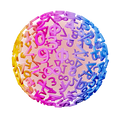
Parentheses with Variables
If a pair of parentheses contain variables instead of numbers, you can’t calculate their contents the same way as you do when it’s just numbers you’re dealing with. The reason is that you don’t know what actually is. Fortunately, there’s a rule you can use, that utilizes the distributive property:
Rule
Parentheses and Variables
In other words, each term inside the parentheses is multiplied by the number or variable outside the parentheses. Here’s an example:
Example 1
Expand the parentheses in the expression
Normally you calculate what’s inside the parentheses first, but as you don’t know what is, you must apply the rule you just saw:
The parentheses have been expanded, and because you still don’t know what is, there’s nothing left to do with this expression.
When you’re multiplying two parentheses that contain numbers, you first find out what’s inside each pair of parentheses, then multiply those answers together.
Example 2
Parentheses and Numbers
Compute
This is often written as , with the multiplication sign or dot omitted. That doesn’t mean the sign is gone, just that it’s invisible:













